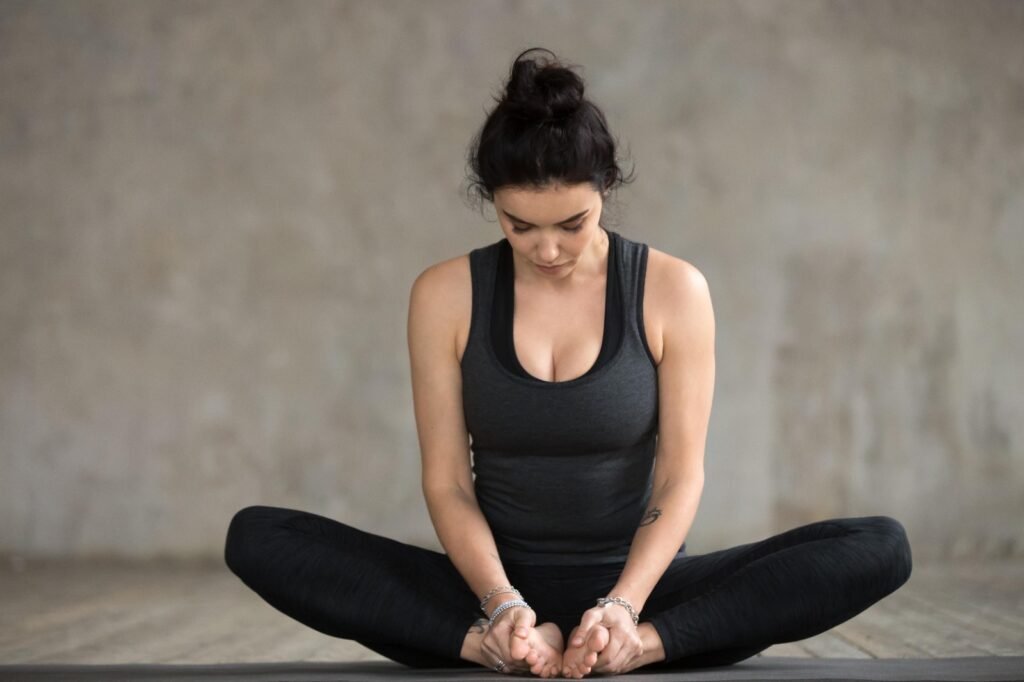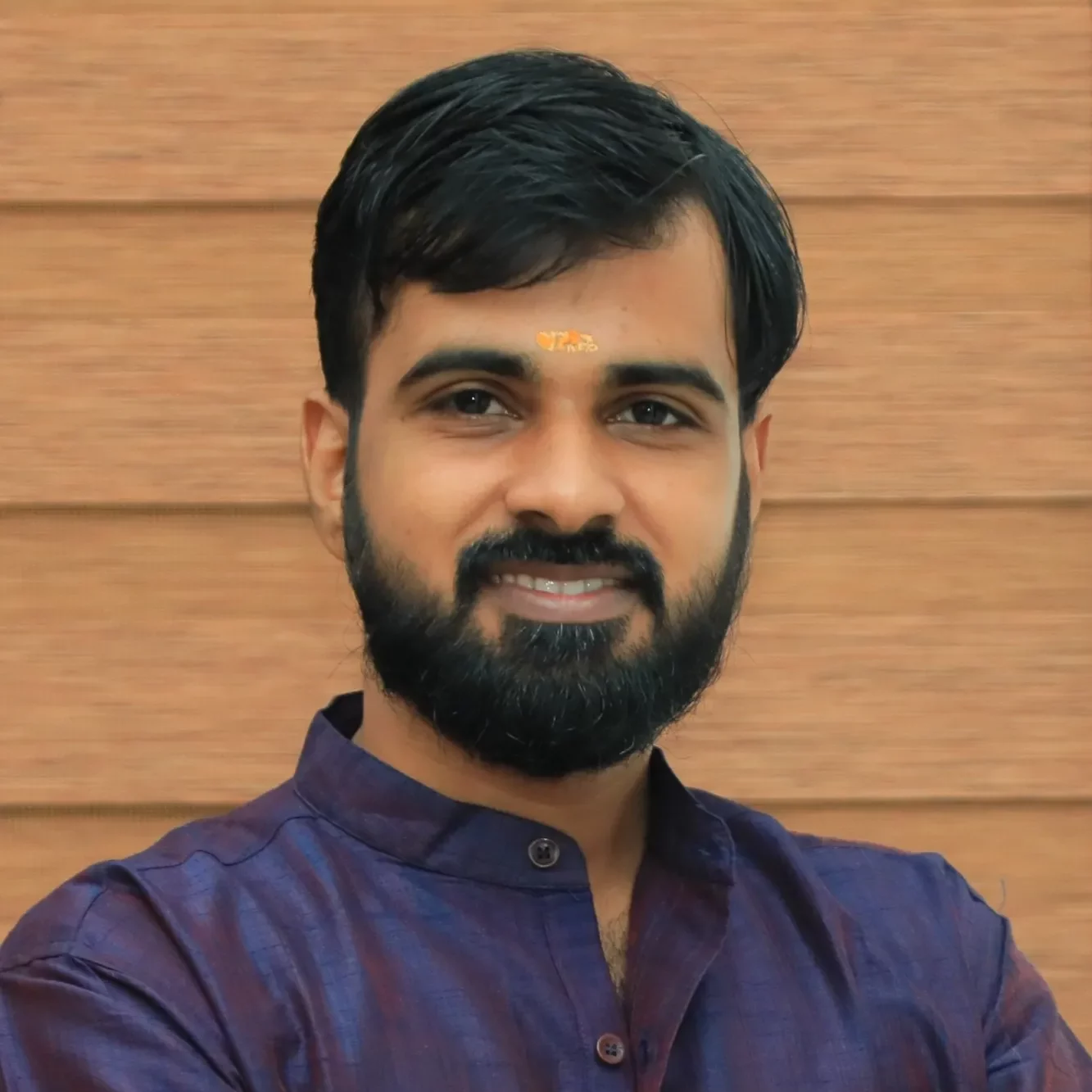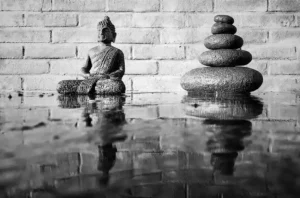Table of Contents
ToggleI am embracing the path of yoga with easy and flexible yogasanas. Here’s the time to learn about a vibrant pose called Baddha Konasana. It is an easily applicable asana, which is also called Butterfly Pose. No matter your age, give a litter life with yoga!.
Baddha Konasana, a synonym for Bound Angle Pose or Butterfly Pose, is a seated yoga posture that focusses on opening the hips and stretching the inner thighs and knees. Here, flexibility occupied the area. In order to do this posture, sit with your legs extended. Bend your knees and bring your foot poles together, making the pose similar to Namaste. Lean your knees towards the floor while using your hands to support your feet. This pose is especially helpful for addressing lower back pain and enhancing posture.
Baddha konasana, meaning
The Sanskrit term “Baddha Konasana” is sometimes known as “Bound Angle Pose” or “Butterfly Pose” in English. Inch by inch is defined as:
- Baddha
The Sanskrit word “Baddha” means “bound” or “restrained.” In the context of yoga, it often refers to a position where certain body parts are held or bound together.
- Kona
The Sanskrit word “kona” translates to “angle” in English. It is commonly used in yoga to describe various poses involving angular positions of the body. For example, “Trikonasana” and “Baddha Konasana”.
- Asana
“Asana” is the Sanskrit word for “pose” or “posture.” It alludes to the many physical positions or postures that are done in the appropriate branch of yoga in order to enhance both mental and physical well-being.
Therefore, the translation of Baddha Konasana is “Bound Angle Pose.” Because of the way the legs form the shape of a butterfly’s wings, this stance is also frequently referred to as the Butterfly stance. In addition to stretching our flexibility, the butterfly posture calms our bodies, promotes relaxation, and clears our minds. This yoga stance is well-known for being simple and adaptable. It gains from having a body that is flexible and elastic. In order to help open the hips and stretch the inner thighs, Baddha Konasana can be done either before or after the Sun Salutation in a yoga practice. It’s a fantastic pose to start or end a yoga practice.
Baddha Konasana (Butterfly Pose) Yoga Benefits
Baddha Konasana is the coolest and easiest asana in classical yoga. The benefits it provides could be an all-time appreciated context. Here are some:
Benefits of Buddha Konasana (Butterfly Pose)
Physical Benefits
- Enhances groin and hip flexibility: The inner thighs and groin area are stretched when sitting with the soles of the feet together. Hip range of motion is increased and the hips are helped to open up in this pose.
- Enhances posture and builds back strength: The pose activates the erector spinae and other back muscles, which helps to build a stronger back and improved posture.
- Boosts blood circulation: It can be advantageous for reproductive health to increase blood flow to the pelvic region by extending the hips and stretching the groin area.
Additionally, it is a proper strategy that might be more advantageous in the event of pregnancy. The Baddha konasana (Butterfly Pose) makes our valva gain a more stretchy nature and maintains a healthy pregnancy journey.
Mental and emotional benefits
- Lessens tension and anxiety: This pose has the potential to be peaceful and meditative, which can help lessen tension and anxiety.
Encourages relaxation and serenity: Let go of all your anxieties and feel at ease to improve your ability to focus. Everybody’s dream is to have a body and mind that are at ease.
How to do Baddha Konasana (Butterfly Pose)
Therefore, it’s an easy, applicable position in the class yoga. There should also be some ratios and guidance while practicing Baddha Konasana. Let’s look at the process:
How to perform Baddha Konasana:
- Sit on the floor with your legs extended forward towards out in front of you.
- Bend your knees and bring the poles of your feet together, allowing your knees to drop out to the sides.
- Hold your feet with your hands, and gently pull your heels towards your pelvis.
- Put your shoulders back and down, and sit up straight, stretching your spine.
- With each exhale, let your knees slide closer to the floor as you maintain the pose for a few deep breaths.
Including Baddha Konasana in your yoga sequences will help you become more flexible, strong, and relaxed. It is a very useful and adaptable pose. In yoga as well, consistency is essential. Gaining a complete feeling and realising the calmness will maintain more power in your mind. Baddha konasana is a perfect example of this.
Common mistakes beginners make:
- Overarching the back.
- Forcing the knees down.
Solution:
- Using properties like cushions or blankets for support.
- Always do warm-up exercises like stretching and etc. before entering Baddha Konasana.
- Always get proper assistance from a certified yoga instructor.
Variations in Baddha Konasana
- Supta Baddha Konasana (Reclining Bound Angle Pose):
- While lying on your back, bring the toes of your feet together and let your knees drop to the sides.
- Put your hands on your belly or hold them above your head.
- This variation is restorative and great for relaxation.
2.Upavistha Baddha Konasana (Seated Wide-Angle Bound Angle Pose):
- Sit with your legs extended forwarded in front of you.
- Bend your knees, bringing the poles of your feet together, and let your knees drop to the sides.
- Hold your feet and slowly pressurise press your knees towards the floor.
- This version increases the stretch in the inner thighs and groin.
3.Baddha Konasana with Forward Bend:
- From the traditional seated Baddha Konasana, hinge at your hips and fold forward.
- Reach your arms in front of you or hold onto your feet or ankles.
- This variation deepens the stretch and can help release tension in the lower back.
4.Supported Baddha Konasana:
- Place yoga blocks or a bolster under your knees for support.
- This modification is helpful for those with tight hips or groin muscles, providing a gentler stretch.
5.Baddha Konasana with a Strap:
- Use a yoga strap around your lower back and loop it around your feet.
- Hold the strap with both hands and gently pull to help deepen the stretch.
- This is useful for those who may have difficulty holding their feet or need more support.
6.Dynamic Baddha Konasana (Butterfly Flap):
- As you sit in Baddha Konasana, gently raise and lower your knees in the manner of a butterfly’s wings.
- This motion improves blood flow to the hip joints and helps them warm up.
7.Baddha Konasana in a Twist:
- With one hand behind you and the other on your knee, sit in Baddha Konasana and slowly shift your torso to one side.
- This version adds a mild spinal twist to increase the spine’s flexibility and mobility.
8.Baddha Konasana with Side Bend:
- Sit in Baddha Konasana and extend one arm over your head, leaning to the opposite side.
- This side stretch can enhance the stretch in the side body and deepen the hip opening.
TIPS FOR PRACTICING BADDHA KONASANA
1. Warm-Up: Always prepare your body by practicing a warm-up exercise like stretching.
2. Proper Alignment: The wrong position in sitting can make it difficult to practice.
3. Support: using props like cushions or blankets can ease the practice.
4. Engage Muscles: Don’t put pressure on muscles; make them relaxed always.
5. Breathing: Do proper breathing exercises before and after the yoga practices; this creates a relaxed feeling for your mind.
Frequency and Duration of Baddha Konasana (Butterfly Pose)
The frequency and duration of practicing Baddha Konasana can depend on your individual goals, flexibility, and overall yoga practice. Here are some general guidelines:
Frequency: 2-3 times per week can be effective for gradually improving flexibility and comfort in the pose. If you are working on a deeper hip opening or incorporating it into a larger sequence,.
Duration: Hold the pose for 1-3 minutes to allow for a deep stretch and relaxation. Start with shorter durations and gradually rise up the time as your flexibility improves.
It’s important to listen to your body. Consistent practice with gradual progression tends to be more beneficial than frequent, intense sessions.
Overview
Yoga is a holistic discipline that balances the mind, body, and spirit. It provides a variety of poses that improve mental and physical health. Of these, the Butterfly Pose (Baddha Konasana) is particularly noteworthy for its mildly firming impact on the hips, groin, and lower back. This sitting position fosters attention and introspection in addition to flexibility and relaxation. Including the importance of yoga as a whole There are vast asanas and poses like Uttanasana (standing forward bend), Virabhdhrasana (warrior pose), etc. that stretch our mind into a calm and relaxing mode.
Hidden Mantra is a complete platform that exemplifies your queries and doubts about yoga practices. From deep insights to exploring yoga poses, the Hidden Mantra blog is an excellent partner. Quench your trust in yoga practices from here and develop a well-maintained and balanced body and soul. Enrich yourselves and lead a happy and healthy life. Namaste!









